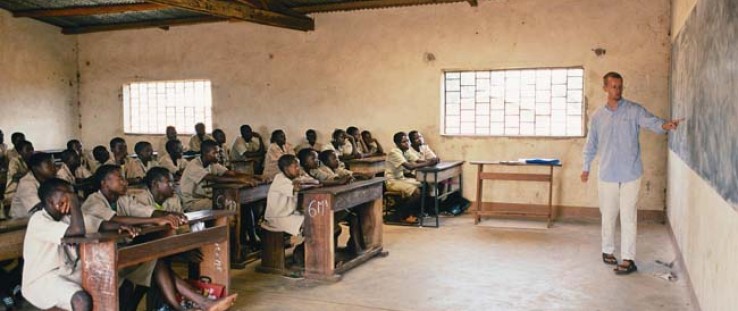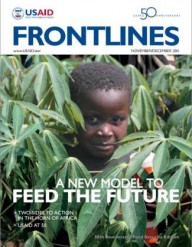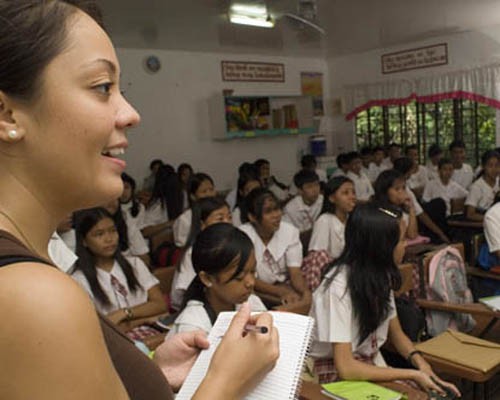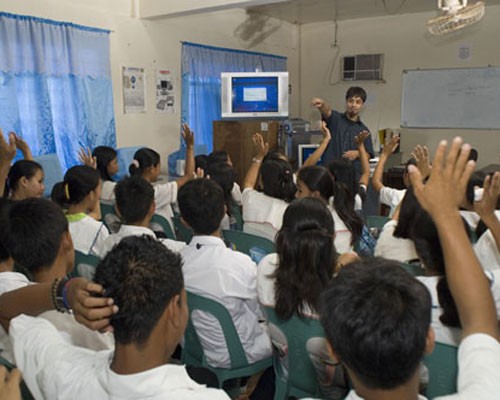 Tuve Floden, a Peace Corps volunteer in Benin, teaches schoolchildren English.
CREDIT: PEACE CORPS
Tuve Floden, a Peace Corps volunteer in Benin, teaches schoolchildren English.
CREDIT: PEACE CORPS
 Tuve Floden, a Peace Corps volunteer in Benin, teaches schoolchildren English.
CREDIT: PEACE CORPS
Tuve Floden, a Peace Corps volunteer in Benin, teaches schoolchildren English.
CREDIT: PEACE CORPS
To mark both agencies’ 50th anniversaries, USAID and the Peace Corps signed the Global Education Framework (GEF) agreement to encourage and enhance collaboration in global education activities.
GEF gives both agencies a flexible way to implement joint education initiatives at the local, national, regional, and global levels in basic education, higher education, youth development, and workforce development.
“The partnership builds on the work of Peace Corps volunteers who have been leaders in education and youth projects for 50 years,” said Peace Corps Director Aaron S. Williams. “We will utilize the agreement to support efforts to enhance the contributions our volunteers are making around the world with local communities at the grassroots level every day.”
The agreement allows USAID missions around the world and bureaus and offices in Washington to contribute funds that support education initiatives being implemented by the Peace Corps and its volunteers. Since the agreement’s inception, USAID has provided nearly $1.8 million in support of seven activities (see box). The collaboration under this agreement has been aimed at providing resources for the Peace Corps to enhance its technical training of volunteers and their host country counterparts.
USAID and the Peace Corps have three global framework agreements that allow this type of collaboration. The USAID/Peace Corps Small Project Assistance Agreement was implemented in 1983; and in July 2011, the agencies signed the Global Food Security Agreement.
The agreement creates a framework under which interested offices and field staff from both agencies can design a wide range of education, gender, and youth programs. For example, USAID support is enabling the development of new training modules for volunteers and staff positions to support common areas of interest such as promoting literacy and reading.
“The Global Education Framework Agreement demonstrates how we are effectively and efficiently programming every development dollar to deliver meaningful results in education,” says USAID Administrator Rajiv Shah. “By working together, we strengthen our organizations to better assist the countries and people we serve.”
The first strategic goal outlined in the new USAID Education Strategy—improving early grade reading—also reflects a Peace Corps focus area in education. Additionally, the three primary crosscutting issues in the strategy—youth programming, gender equality, and learners with disabilities—are all key programming areas for the Peace Corps.
“This important collaboration helps USAID meet its education goals while helping support Peace Corps and its local partners to reach greater numbers of learners both in and out of school,” says Richard Whelden, director of USAID’s Education Office and a returned Peace Corps volunteer who served in Chad from 1974 to 1978. “We also recognize that today’s volunteers are increasingly connected and bring valuable knowledge and other tech-savvy skills and expertise to the communities where they are serving.”
Over 200,000 Americans have served as Peace Corps volunteers since 1961, working in 139 counties to promote world peace and friendship. Currently, there are 8,655 Peace Corps volunteers serving in 76 countries worldwide. Approximately 40 percent of all volunteers today are assigned in either education or youth sectors, and over 60 percent of all volunteers report working with youth in their primary assignments.
Global Education
Under the Global Education Framework agreement, the following activities are being supported:
- Development and piloting of new international training and workshop materials for volunteers and staffers to promote data-driven education decision-making at the community level;
- Training to aid teachers and school officials in the two-year Peace Corps Education Assistance Project for Mindanao, Philippines;
- Volunteers providing English language instruction to judges and court staff under the Millenium Challenge Corporation Rwanda Justice Strengthening Project;
- Design, development, and delivery of training materials for “Creating an Enabling Classroom Environment for Improved Reading and Learning Activity”
Peace Corps, Washington, D.C., hiring a full-time literacy specialist and program support to better systematize and expand efforts already under way in early grade reading and literacy; - Creation and delivery of training materials in “Life Skills and Leadership for Youth Activity”; and
- A baseline education assessment study in South Africa prior to Peace Corps expansion of education project into a new region of the country.
SOURCE: PEACE CORPS
Regardless of volunteers’ primary assignments, many work to support and develop the skills and capacities of young people and teachers. Volunteers are often placed in rural communities outside the reach of other institutions. They act as conduits, helping youth make the connection from school to work.
Peace Corps volunteers develop language, cross-cultural, and technical skills that can be applied on a broader scale once they end their service. Many returned Peace Corps volunteers continue public service by working at U.S. Government agencies, including USAID.
Peace Corps officials say the collaboration with USAID could help to enhance projects like one in Paraguay, where two Peace Corps volunteers helped construct and stock a library after noting the poor reading skills of community members. The effort, which began in 2009, became Biblioteca Ñemoaranduhagua, Guarani for: “To learn more/In Order to Know More Library,” nearly one year later. It is now a fully functional library with a technology area, teacher resources, and around 700 books for all ages and interest levels.
With USAID’s support, more projects like this could be established throughout the country.
“As USAID and Peace Corps look to the past and celebrate 50 years of collaboration as leaders in global education, this innovative partnership ensures the two agencies are looking ahead to solve the development priorities of tomorrow,” added Williams.
For more information on the Global Education Framework agreement, please contact the Peace Corps’ Sara Lopez, Office of Intergovernmental Affairs and Partnerships, slopez2@peacecorps.gov, and USAID’s Anthony Bloome, Office of Education, abloome@usaid.gov.











Comment
Make a general inquiry or suggest an improvement.